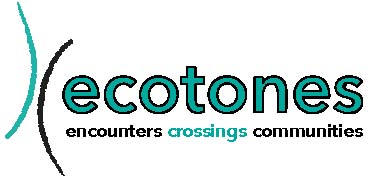Présentation des sessions > Session 7: camps de réfugiésSession 7: Camps de réfugiés Samedi 24 juin, 9h30-11h00 Animé par Thomas Lacroix
Rafik Arfaoui: Les effets de la structure des écotones sur l’accueil et l’intégration des demandeurs d’asile dans les territoires non-métropolitains Les demandeurs d’asile accueillis en France, ces deux dernières années, sont confrontés aux nouvelles politiques publiques, initiées par l’État en 2015, visant à désengorger les « camps de migrants » installés à Paris et à Calais. Il s’agit d’une relocalisation des demandeurs d’asile à travers le territoire national. Les espaces situés en dehors de l’influence des métropoles (Paris, Lyon…), ou ce qu’on pourrait appeler territoires non-métropolitains, qui ne constituent pas des espaces de destination pour les demandeurs d’asile pour différentes raisons (économiques, sociales, choix de l’itinéraire migratoire par les réseaux de passeurs…), les accueille, désormais, dans des structures d’hébergement (CADA , CAO …). Ce sont des écotones spatio-temporels, des milieux de transit où les demandeurs d’asile sont accueillis pendant la période de traitement de leur demande. Dans ces écotones, il existe deux visions, deux tendances contradictoires de la population locale. Si une partie d’entre-elle refuse catégoriquement l’idée même d’installer une structure d’hébergement à des « étrangers qu’ils stigmatisent », une autre partie vante les avantages (économiques et démographiques) qu’apporte cet accueil (Bonerandi, 2008). Comment se fait, donc, l’intégration temporaire des demandeurs d’asile dans ces écotones? Outre la problématique d’ordre social, il y a celle de l’accessibilité à la culture et aux espaces publics. Comment se fait-elle dans des écotones où la mobilité est réduite par le manque de moyens de transport en commun ? Pour répondre à ces questions, cette communication s’appuiera, d'une part, sur les récits des demandeurs d'asile que j'ai interrogés et, d'autre part, sur les cartes mentales qu'ils ont dessinées lors des entretiens qu'ils m'ont accordés.
Johan Jacobs: Narrative zones of refuge in A Man of Good Hope by Jonny Steinberg In A Man of Good Hope (2014), award-winning South African journalist Jonny Steinberg gives a richly self-reflexive account of the experiences of the Somali refugee, Asad Abdullahi, from when, in 1991, at the age of eight, he fled, together with other Daarood people, from his home in Mogadishu to escape the butchery of the Hawiye militiamen, who killed his mother. Asad’s memories of the main stages in his subsequent life of flight, abandonment and struggle for survival begin in the refugee settlements in Afmadow and Dhoobley in Somalia, the UNCHR camp outside Liboi in northeast Kenya, the Somali district of Islii in Nairobi, the towns of Dire Dawa and Wardheer in the Somali region of Ethiopia, and the Bole Mikhael neighbourhood in Addis Ababa. Asad’s experiences in these paradoxical zones of refuge and flight, together with his account of how he eventually followed the refugee route – via Somalia, Kenya, Tanzania, Zambia and Zimbabwe – to South Africa, provide a narrative map of the Somali diaspora. Asad’s tiny, fortified shack store in a black South African township proves to be yet another contingent zone of refuge when he becomes caught up in the waves of xenophobic violence against Somali shopkeepers in 2008 that resulted in many being killed and their shops looted. The main focus of the paper will be on the various ways in which the story of these zones of refuge is co-created between the author and his Somali diasporic subject, and how it is contained within an elaborate meta-narrative around the identity and self-perception of the refugee, and ultimately around what it means to Steinberg to have been “under the skin of a human being that I am not”, and to Asad to have had his life memorialised.
Zsolt Mate: The intercultural approaches of the U.S. Army in Camp Kilmer with the 1956 Hungarian refugees In my presentation I would like to introduce the U.S. Army’s reaction and reception of the 1956 Hungarian refugees in Camp Kilmer. During and after the 1956 Hungarian revolution almost 200 000 people left their homeland, mainly to Austria and Jugoslavia. An international cooperation started shortly after 4th of November to help Austria, because the country, which only a year ago achieved it’s independence could not integrate this many people in a short period of time. The United States accepted the most refugees from Austria, until the end of May in 1957 around 32 000 people was helped in the Operation Mercy. Camp Kilmer was a military camp in New Brunswick, NJ where all the refugees spend their first days and weeks, until their paperwork was not over. The focus of my presentation is how was the intercultural reaction and communication with the Hungarian refugees. Only a few percent of the refugees spoke in English, so the U.S. Army not just collected as many translators as possible, but every sign became bilingual. The social programs in Camp Kilmer show interesting results, because, meanwhile American holidays were celebrated (for example Thanksgiving), the Hungarian traditions were supported by the U.S. Army. In the presentation I would like to analyze this questions with some remarks to the religious life, social activities. With this we will be able to understand the first steps of one of the most successful integration process in the U.S. history and we can study from a good example of using military forces in a humanitarian crisis. |


